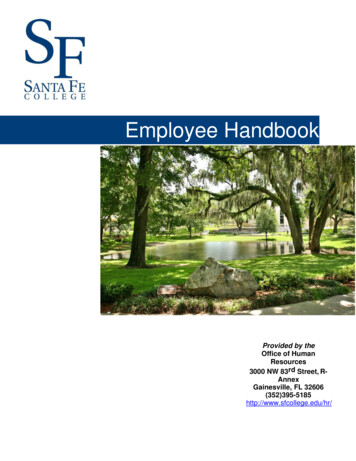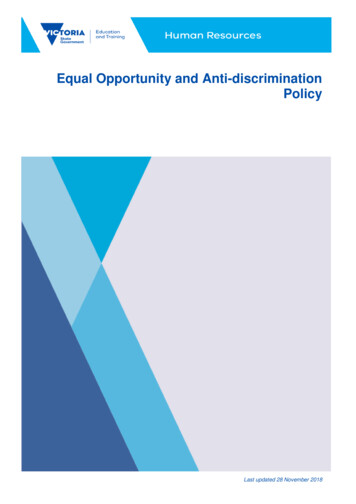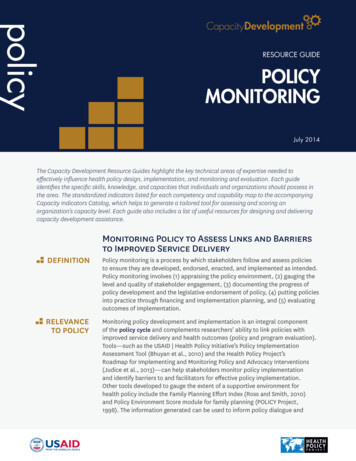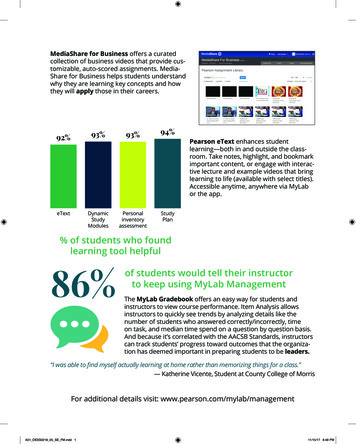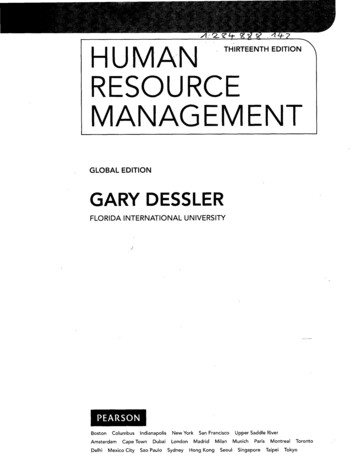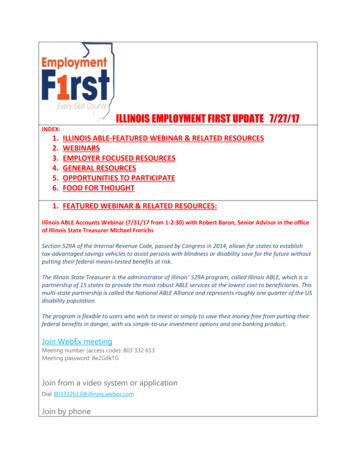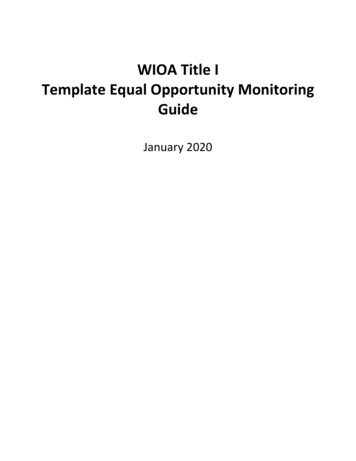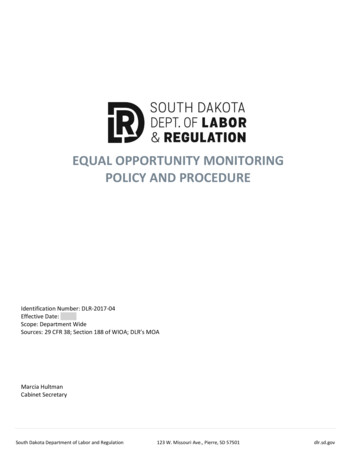
Transcription
EQUAL OPPORTUNITY MONITORINGPOLICY AND PROCEDUREIdentification Number: DLR-2017-04Effective Date:Scope: Department WideSources: 29 CFR 38; Section 188 of WIOA; DLR’s MOAMarcia HultmanCabinet SecretarySouth Dakota Department of Labor and Regulation123 W. Missouri Ave., Pierre, SD 57501dlr.sd.gov
I.I.Table of ContentsTable of Contents . 2II. Purpose . 3III. Equal Opportunity Monitoring Policy . 3A. Equal Opportunity Monitoring Responsibility . 3B. Equal Opportunity Monitoring Frequency . 3C. Equal Opportunity Requirements . 3D. Equal Opportunity Monitoring Tools. 4E. Elements of the Monitoring . 4IV. Equal Opportunity Monitoring Procedures . 4A.B.C.D.E.F.G.H.Notification Letter and Monitoring Tools. 4Statistical Analysis – Desk Review . 4On-Site Review . 4Exit Conference . 5Initial Determination Letter. 5Follow-up – Findings of Noncompliance . 5Final Determination. 6Sanctions . 6Equal Opportunity Monitoring Policy and Procedure2 Page
II.PurposeThe goal of this manual is to ensure the South Dakota Department of Labor and Regulation (DLR) is compliantwith all federal and State laws and to prevent discrimination and retaliation in the workplace. DLR will monitorjob service offices and subrecipients who receive WIOA Title I funds through DLR to ensure compliance withWIOA section 188 and 29 CFR 38, including a determination as to whether each recipient is conducting itsWIOA Title I-financially assisted program or activity in a nondiscriminatory way.III.Equal Opportunity Monitoring PolicyAt minimum, each periodic monitoring review will include:1. A statistical or other quantifiable analysis of records and data kept by the recipient under § 38.51,including analyses by race/ethnicity, sex, age, and disability status;2. An investigation of any significant differences identified in paragraph (d)(2)(ii)(A) of this section inparticipation in the programs, activities, or employment provided by the recipient, to determine whetherthese differences appear to be caused by discrimination. This investigation must be conducted throughreview of the recipient’s records and any other appropriate means; and3. An assessment to determine whether the recipient has fulfilled its administrative obligations undersection 188 or this part (for example, recordkeeping, notice and communication) and any duties assignedto it under the MOA;A. Equal Opportunity Monitoring ResponsibilityDLR’s EO Officer will have the overall responsibility for equal opportunity monitoring. Job service office EOCoordinators will assist the Equal Opportunity (EO) Officer in conducting the reviews.B. Equal Opportunity Monitoring FrequencyThe EO Officer will schedule desk reviews of each job service office and sub-recipient on an annual basis. TheDLR EO Officer shall collaborate with the Equal Opportunity (EO) Coordinators to do on-site visits of their OneStop Career Centers, once every three (3) years, unless a complaint is received or a desk audit indicates the needof an immediate on-site review.C. Equal Opportunity Requirements1. Each equal opportunity monitoring review shall include a review of each job service office and/or subrecipient’s:a. Compliance with its administrative obligations under WIOA section 188 and 29 CFR 38;b. Compliance with responsibilities it has been assigned through the MOA;c. Programs and activities to determine whether discrimination is occurring.2. Such monitoring review shall include a statistical or other quantifiable analysis of data and records collectedby DLR and/or sub-recipients, including analyses by race/ethnicity, sex, age, and disability status, pursuantto 29 CFR 38.51. An investigation of any significant differences identified in participation in the programs,activities, or employment provided by DLR, to determine whether these differences appear to be caused bydiscrimination. This investigation must be conducted through review of the recipient’s records and any otherappropriate means.3. Both desk and on-site monitoring reviews will assess each recipient’s compliance with 29 CFR 38 related to:a. Element 1: Designation of EO Officerb. Element 2: Notice and Communicationc. Element 3: Assurancesd. Element 4: Universal Accesse. Element 5: Compliance with Section 504f. Element 6: Data and Information Collection and MaintenanceEqual Opportunity Monitoring Policy and Procedure3 Page
g. Element 7: Monitor Recipients for Complianceh. Element 8: Complaint Processing Proceduresi. Element 9: Corrective Actions/SanctionsD. Equal Opportunity Monitoring ToolsDLR EO Officer monitors One-Stop Career Centers and subrecipients receiving WIOA Title I-funding byconducting desk and or on-site monitoring reviews using a monitoring tool (see MOA Element 7, Exhibit A). Thetool meets all requirements outlined in section 3 of this element.E. Elements of the Monitoring1. The desk monitoring review shall consist of the following segments:a. Notification Letter – Including Monitoring Toolsb. Statistical Analysis – Desk Reviewc. Monitoring Report – Report of resultsd. Follow-up – Corrective Actions/Sanctions2. The on-site monitoring review shall consist of the following segments:a. Notification Letter – Including Monitoring Toolsb. Statistical Analysis – Desk Reviewc. Onsite Reviewd. Exiting Conferencee. Monitoring Report – Report of resultsf. Follow-up – Corrective Actions/SanctionsIV.Equal Opportunity Monitoring ProceduresA. Notification Letter and Monitoring ToolsThe notification letter announces the details and scope of the review. The letter should be sent 30 days prior tothe review to the appropriate EO Coordinator/Administrator. The monitoring tools should accompany the letter.The letter should include instructions for the monitoring tools and all applicable supporting documentsrequested be returned at least ten (10) days prior to the review.B. Statistical Analysis – Desk ReviewUpon receipt of the preliminary demographic information, the desk review should be performed. The reviewershould analyze the statistical information and written program reports received, as well as the monitoring toolsresponses. This part of the process may help to identify potential items to be addressed during the on-sitereview and help the reviewer prepare an action plan based on the results of the desk review.C. On-Site ReviewThe focus of the on-site review is to determine compliance with equal opportunity and nondiscriminationrequirements and to review significant differences or disparities identified during the desk review. It isrecommended, upon entering the site, the reviewer meet with the appropriate EO Coordinators/Administratorto discuss the scope of the review, to make arrangements for client and staff interviews or file reviews, and todiscuss preliminary findings.The following are areas of emphasis during the on-site review:1. Staff composition;2. Management and client interviews;3. Staff awareness of nondiscrimination and equal opportunity laws;4. Complaint files (if appropriate);Equal Opportunity Monitoring Policy and Procedure4 Page
5.6.7.8.9.Client files;Physical aspects of the site — programmatic and architectural accessibility;Observance of reception, intake, and assessment processes, if applicable;Maintenance of equal opportunity policies and complaint files;Interviews with community-based organizations (when complaints or concerns have been identified orexpressed);10. Agreements with local organizations to provide needed services to persons with special needs; and11. Display of announcement, mandatory WIOA "Equal Opportunity is the Law" posters, and posters and signsfor clients with limited English-speaking abilities.D. Exit ConferenceImmediately following the review, the reviewer may conduct an exit meeting with the appropriate EOCoordinator/Administrator or designee to discuss the findings and clarify areas in question. A preliminarycompliance status may be given at this time, and corrective action(s) may be suggested.E. Initial Determination LetterAt the conclusion of the monitoring review process, an "Initial Determination Letter" shall be written by the EOOfficer conducting the review. The report shall be due within thirty (30) working days of the completion of thereview. Copies of the report shall be distributed to the recipient's management. A copy shall be maintained bythe local EO Officer conducting the review. The written report shall contain all the information pertinent to thereview, including the following:1. Name, location, and contact information of the recipient reviewed;2. A brief description of the services or program provided by the recipient;3. Name and contact information of the EO Officer conducting the review;4. Reason(s) for the review;5. Results of any analytical data;6. Names of staff interviewed;7. Names of participants interviewed;8. Overall results of the review;9. Any findings of noncompliance including condition, cause, and criteria;10. Sanctions or corrective actions called for; and,11. Method and time frame for follow-up.In areas of noncompliance, the reviewer shall make required corrective action(s) in the report.If management agrees with the corrective actions, an implementation plan shall be forwarded to the reviewerwithin thirty (30) days of the date recommendations are received.However, if management disagrees with recommendations, management shall contact the reviewer to attemptan informal resolution of the issue(s).1. Where an informal resolution is reached, an implementation plan shall be forwarded to the reviewer withinthirty (30) days of the date recommendations are received.2. Where an informal resolution is not reached, a meeting shall be held among the reviewer, State EO Officer,and the appropriate management official for the program/unit under review.Six to nine months after the recommendations are implemented; another (follow-up) review shall be scheduledby the State EO Officer to assess the progress made in resolving the identified problem areas.F. Follow-up – Findings of NoncomplianceIf the investigating authority finds reasonable cause to believe the recipient has violated the nondiscriminationand equal opportunity provisions of WIOA, 29 CFR 38 during the initial compliance review, a follow-up shall beEqual Opportunity Monitoring Policy and Procedure5 Page
conducted by the reviewing officer regarding any corrective actions or sanctions. (See Element 9 of this MOA foradditional information on this subject matter.)G. Final Determination1. If compliance cannot be secured by voluntary means, the EO Officer must either:a. Issue a Final Determination;b. Refer the matter to a DLR staff attorney with a recommendation that an appropriate civil action beinstituted; orc. Take such other action as may be provided by law.2. A Final Determination must contain the following information:a. A statement of the efforts made to achieve voluntary compliance, and a statement that those effortshave been unsuccessful;b. A statement of those matters upon which the parties continue to disagree;c. A list of any modifications to the findings of fact or conclusions that were set forth in the InitialDetermination, Notice to Show Cause, or Letter of Findings;d. A statement of the sub-recipients, contractors, and other service providers’ (such as eligible trainingproviders) liability, and, if appropriate, the extent of that liability;e. A description of the corrective or remedial actions the grant applicant or recipient must take to comeinto compliance;f. A notice that if the grant applicant or recipient fails to come into compliance within 10 days of the dateon which it receives the Final Determination, one or more of the following consequences may result:i.After the sub-recipients, contractors, and other service providers (such as eligible training providers)are given the opportunity for a hearing, its WIOA funds may be terminated, discontinued, or withheldin whole or in part, or its application for such funds may be denied, as appropriate;ii.DLR may refer the case to a DLR staff attorney with a request to file suit against the sub-recipients,contractors, and other service providers; oriii.DLR may take any other actions against the sub-recipients, contractors, and other service providersthat are provided by law.j. A notice of the grant applicant’s or recipient’s right to request a hearing under the procedures describedin 29 CFR 38.111; andk. A determination of DLR, entity’s authorized signatory, and the violating sub-recipient, contractors, andother service provider’s liability, if any.H. Sanctions1. If compliance has not been achieved after issuance of a Final Determination or a Notification of Breach ofConciliation Agreement, DLR may apply sanctions or judicial enforcement as follows:a. After opportunity for a hearing, suspend, terminate, deny or discontinue the WIOA financial assistance,in whole or in part;b. Refer the matter to a DLR staff attorney or CRC with a recommendation that an appropriate civil actionbe instituted; orc. Take such action as may be provided by law.2. In addition to sanctions and judicial enforcement, if there is no voluntary compliance there may be adeferral of new grants. When the applicable hearing procedures have been initiated against a particularrecipient, DLR or the CRC may defer action on that recipient's applications for new WIOA financial assistanceuntil a Final Decision as required has been rendered. Deferral is not appropriate when WIOA financialassistance is due and payable under a previously approved application. The following criteria are applied todetermine New WIOA financial assistance:Equal Opportunity Monitoring Policy and Procedure6 Page
a. New WIOA financial assistance includes all assistance for which an application or approval, includingrenewal or continuation of existing activities, or authorization of new activities, is required during thedeferral period.b. New WIOA financial assistance does not include assistance approved before the beginning ofproceedings, or increases in funding because of changed computations of formula awards.Equal Opportunity Monitoring Policy and Procedure7 Page
D. Equal Opportunity Monitoring Tools DLR EO Officer monitors One-Stop Career Centers and subrecipients receiving WIOA Title I-funding by conducting desk and or on-site monitoring reviews using a monitoring tool (see MOA Element 7, Exhibit A). The tool meets all requirements outlined in section 3 of this element. E. Elements of the Monitoring 1.

